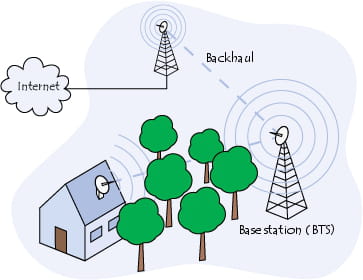What is the WiMAX technology: vs WiFi, LTE

What is WiMAX? WiMAX stands for Worldwide Interoperability for Microwave Access. It is a metropolitan wireless standard created by Intel and Alvarion in 2002 and ratified by the IEEE (Institute of Electrical and Electronics Engineers) under the name IEEE-802.16. More precisely, WiMAX is the commercial designation that the WiMAX Forum gives to devices that conform to the IEEE 802.16 standard to ensure a high level of interoperability among them.
What are the goals of WiMAX?
WiMAX aims to provide high-speed Internet access in a coverage range of several kilometers. In theory, WiMAX’s speed is around 70 Mbps with a range of 50 kilometers. The WiMAX standard allows wireless connections between a base transceiver station (BTS) and thousands of subscribers without requiring that they be in a direct line of sight (LOS) with that station. This technology is called NLOS for non-line-of-sight. In reality, WiMAX can only bypass small obstructions like trees or houses and cannot cross hills or large buildings. When obstructions are present, actual throughput might be under 20 Mbps.
What are the differences with WMAN?
A Wireless Metropolitan Area Network (WMAN) is also known as a Wireless Local Loop (WLL). WMANs are based on the IEEE 802.16 standard. The wireless local loop can reach effective transfer speeds of 1 to 10 Mbps within a range of 4 to 10 kilometers, which makes it useful mainly for telecommunications companies. The best-known wireless metropolitan area network is WiMAX, which can reach a speed on the order of 70 Mbps over a radius of several kilometers.
What is the operating principle of WiMAX?
At the heart of WiMAX technology is the BTS, a central antenna that communicates with subscribers' antennas. The term point-multipoint link is used for WiMAX's method of communication.
What are fixed WiMAX and WiMAX portable?
The revisions of the IEEE 802.16 standard fall into two categories:
- Fixed WiMAX: also called IEEE 802.16-2004, it provides for a fixed-line connection with an antenna mounted on a rooftop, like a TV antenna. Fixed WiMAX operates in the 2.5 GHz and 3.5 GHz frequency bands (that require a licence), as well as the licence-free 5.8 GHz band.
- Mobile WiMAX: also called IEEE 802.16e, allows mobile client machines to be connected to the Internet. Mobile WiMAX opens the doors to mobile phone use over IP, and even high-speed mobile services.
| Standard | Frequency | Speed | Range |
|---|---|---|---|
| Fixed WiMAX (802.16-2004) | 2-11 GHz (3.5 GHz in Europe) | 75 Mbps | 10 km |
| Mobile WiMAX (802.16e) | 2-6 GHz | 30 Mbps | 3.5 km |
How can you apply WiMAX?
One of WiMAX's potential uses is to cover the so-called last mile"(or "last kilometer”) area, meaning providing high-speed Internet access to areas that normal wired technologies do not cover (such as DSL, cable, or dedicated T1 lines).
Another possibility involves using WiMAX as a backhaul between two local wireless networks, such as those using the WiFi standard. WiMAX will ultimately enable two different hotspots to be linked to create a mesh network.

WiMAX and Quality of Service
The WiMAX standard supports Quality of Service (often called QoS for short), the ability to ensure that a service works when used. In practice, WiMAX lets bandwidth be reserved for a given purpose. Some applications cannot work properly when bottlenecks occur. This is the case for Voice Over IP (VOIP), as spoken communication is ineffective when a second-long gap is introduced.
WiMAX Standards
| Standard | Frequency | Status | Range |
|---|---|---|---|
| IEEE std 802.16 | Defines wireless metropolitan area networks (WMANs) on frequency bands higher than 10 GHz. | October 2002 | Obsolete |
| IEEE std 802.16a | Defines wireless metropolitan area networks on frequency bands from 2 to 11 GHz inclusive. | October 9, 2003 | Obsolete |
| IEEE 802.16b | Defines wireless metropolitan area networks on frequency bands from 10 to 60 GHz inclusive. | Merged with 802.16a (Obsolete) | |
| IEEE std 802.16c | Defines options (profiles) for wireless metropolitan area networks in unlicensed frequency bands. | July 2003 | |
| IEEE 802.16d (IEEE std 802.16-2004) | Revision incorporating the 802.16, 802.16a, and 802.16c standards. | October 1st, 2004 | Active |
| IEEE std 802.16e | Allows wireless metropolitan area networks to be used by mobile clients. | not ratified | |
| IEEE std 802.16f | Allows wireless mesh networks to be used. | not ratified |
